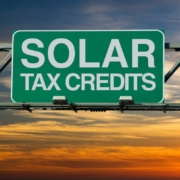HOME ENERGY CREDITS
Tax Credit for Residential Energy Improvements – A credit for energy-savings improvements made to a taxpayer’s principal residence located in the United States is available through 2016. The credit generally equals 10% of a homeowner’s cost of eligible energy-saving improvements, up to a maximum lifetime tax credit of $500. Thus for the current year, if the total of nonbusiness energy property credits taken in prior years is more than $500, no credit is allowed in the current year. Some of the energy property categories have lower limits, such as $200 for exterior windows and skylights.
The cost of certain high-efficiency heating and air conditioning systems, water heaters, and stoves that burn biomass all qualify, along with labor costs for installing these items. The cost of energy-efficient windows and skylights, energy-efficient doors, qualifying insulation, and certain roofs also qualify for the credit; however, the cost of installing, including onsite preparation, assembly, or original installation of the component is not included.
The improvement’s original use must commence with the taxpayer, and the improvement must reasonably be expected to remain in use for at least five years. Credit generally applies to the following:
- Qualified advanced main air circulating fan (used in a natural gas, propane, or oil furnace);
- Qualified energy-efficient heat pumps;
- Qualified energy-efficient water heaters;
- Qualified energy-efficient central air conditioners;
- Qualifying insulation;
- Qualified exterior windows, including skylights;
- Qualified exterior doors;
- Qualified metal roofs coated with heat-reduction pigments; and
- Qualified asphalt roofing with appropriate cooling granules.
Credit limitations – The credit is limited to the amount of income tax less certain other personal credits. If the residential energy improvement credit is greater than the amount the taxpayer’s tax, the excess is lost; it cannot be carried over to another year.
Tax Credit for Residential Energy Efficient Property (Solar credit)
This credit is available for years noted below. The installation must be on the taxpayer’s main or second home located in the United States. Although this credit is most well known for the tax credit it provides for solar installations, it also provides credit for the costs of fuel cell equipment, qualified wind energy equipment and qualified geothermal energy equipment. The credit percentages and credit expiration dates are:
Fuel cell, wind energy and geothermal equipment:
Credit available: through 2016
Credit percentage is: 30% (no dollar maximum)
Solar electric property and solar water heaters – The credit phases out over a period of years by reducing the credit rate for the year. However, there is no dollar limit for the credit.
| Year | Credit Percentage |
| Through 2019 | 30% |
| 2020 | 26% |
| 2021 | 22% |
Labor costs for onsite installation and for piping and wiring connections are qualifying costs for these credits. However, the credits do not apply to equipment used to heat swimming pools or hot tubs.
Credit limitations – Although the residential energy efficient property credits can be used to offset both the regular tax and AMT, they are nonrefundable personal credits that can only reduce a taxpayer’s tax to zero; any remaining balance is not refundable. If the amount of the credit exceeds the taxpayer’s tax after subtracting other nonrefundable personal credits, the excess may be carried forward to the next tax year and added to the credit allowable for that year. CAUTION: Advertisements promoting solar systems advertise the credit, but avoid mentioning it is non-refundable. So if you are counting on the credit to cover a significant portion of your cost, it will do so only if your tax liability is large enough to absorb the full credit.







Leave a Reply
Want to join the discussion?Feel free to contribute!